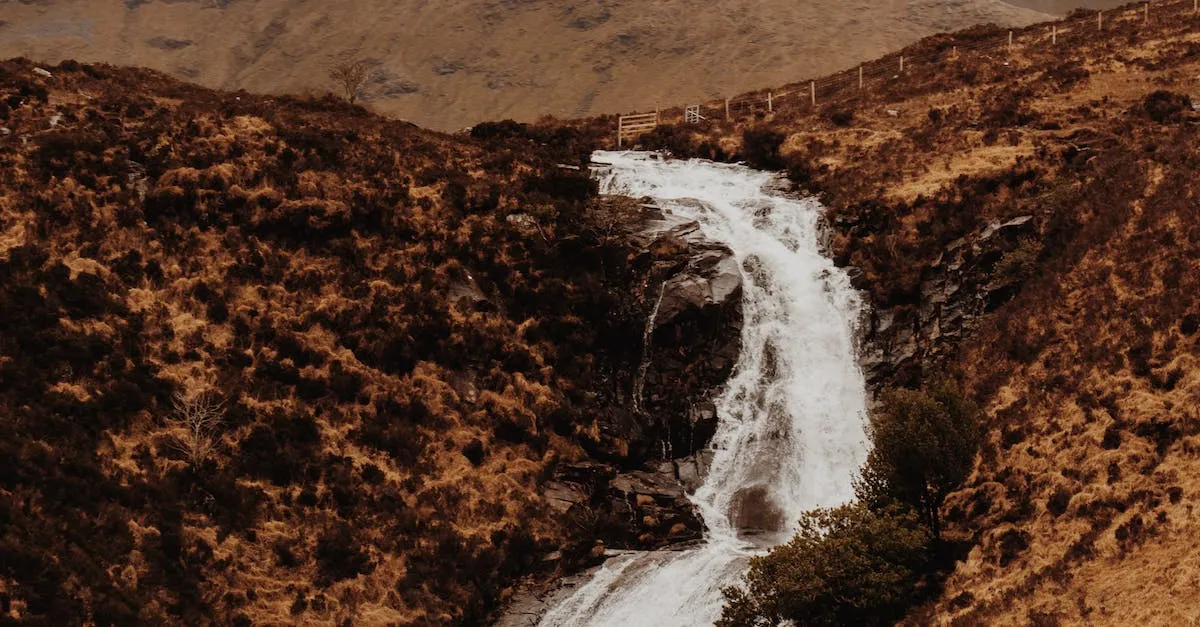Why Is The Colorado River Brown?
Known for carving dramatic gorges and canyons through the desert southwest, the Colorado River is an iconic waterway. However, instead of blue, the river often has a noticeable brown, muddy color. So what causes the Colorado River’s brown hue?
If you’re short on time, here’s the quick answer: The Colorado River is brown due to the high sediment content it carries from eroding surrounding desert terrain.
In this in-depth guide, we’ll explore the factors that contribute to the Colorado River’s brown coloration. You’ll learn about the river’s geography, origins, seasonal variations in color, and how human activity impacts sediment levels.
Origins and Route Through the Desert
The Colorado River, known for its distinct brown color, begins its journey high up in the Rocky Mountains. Its headwaters can be found in Colorado, where melting snow and rainfall feed into the river. The river then winds its way through several states, including Wyoming, Utah, Nevada, Arizona, California, and finally flows into the Gulf of California in Mexico.
Rocky Mountain headwaters
The pristine waters of the Colorado River start their journey in the majestic Rocky Mountains. As the snow melts during the spring and summer months, it creates a steady flow of water that feeds into the river.
This water is relatively clear and pure, which gives the river its initial blue appearance.
However, as the river travels downstream, it encounters various factors that contribute to its brown color. One of the primary reasons for the change in color is the sediment and minerals that are present in the river.
The Colorado River passes through areas rich in sediment, such as canyons and valleys. As the water flows through these regions, it picks up fine particles of sand, silt, and clay. These particles are carried along in the river, giving it a brownish hue.
Journey through arid, erosion-prone landscape
The journey of the Colorado River takes it through an arid and erosion-prone landscape. This region is characterized by dry, rocky terrain, which contributes to the river’s brown color.
As the river flows through the desert, it encounters eroded rocks and cliffs. The constant erosion of these natural formations releases sediment into the river, further adding to its brownish color. Additionally, the arid climate leads to less vegetation and less vegetation means less organic matter in the river, which can also contribute to its brown appearance.
It’s important to note that the brown color of the Colorado River does not necessarily indicate pollution or contamination. While the river does face challenges, such as water scarcity and pollution from human activities, the natural sediment and minerals are the primary factors behind its distinctive color.
For more information about the Colorado River and its unique characteristics, you can visit www.usbr.gov/lc/region/g1000/river.html.
High Sediment Causes Brown Color
The Colorado River is known for its distinctive brown color, which is mainly caused by high levels of sediment suspended in the water. Sediment refers to eroded soil particles that have been carried into the river through various means such as runoff from surrounding areas, erosion from riverbanks, and tributary inputs.
As the river flows, it picks up these tiny particles, giving it a characteristic brown hue.
Eroded soil suspended in water
One of the primary reasons for the brown color of the Colorado River is the high concentration of eroded soil suspended in the water. This sediment comes from a variety of sources, including natural erosion processes, agricultural activities, and urban development.
When it rains, water washes away soil particles from the land, transporting them into the river. These particles remain suspended in the water, causing it to appear brown.
The sediment in the Colorado River is composed of different minerals and organic matter, which further contribute to its color. The composition of sediment can vary depending on the geology and land use practices in the surrounding areas.
For example, sediments from agricultural areas may contain higher levels of nutrients and organic matter, while sediments from urban areas may contain pollutants and debris.
Changes with seasonal rainfall and runoff
The brown color of the Colorado River can also vary depending on the seasonal rainfall and runoff patterns. During periods of heavy rainfall or snowmelt, the river experiences increased water flow and higher sediment loads.
This can intensify the brown color, as more soil particles are being carried into the river.
Conversely, during dry periods when there is less rainfall and runoff, the sediment concentration in the river may decrease, resulting in a lighter color. These seasonal variations in sediment levels can have a significant impact on the overall appearance of the river.
It is important to note that while the brown color of the Colorado River may not be visually appealing to some, it is a natural characteristic of the river and does not necessarily indicate pollution.
The river plays a vital role in supporting diverse ecosystems and providing water for various human activities. Efforts are underway to manage sedimentation in the Colorado River and ensure its long-term sustainability.
Effects From Nearby Land Use
The brown color of the Colorado River can be attributed to several factors, including the effects of nearby land use. The river flows through a diverse landscape, passing through agricultural areas, urban environments, and natural habitats.
Each of these land uses can contribute to the discoloration of the river water.
Agricultural runoff
One of the main contributors to the brown color of the Colorado River is agricultural runoff. The region surrounding the river is known for its extensive farming activities, including the cultivation of crops and the raising of livestock.
During periods of heavy rainfall or irrigation, excess water carries sediment, fertilizers, and pesticides from the fields into the river. These substances can give the water a muddy or brownish appearance.
The impact of agricultural runoff on water quality is a major concern for both the health of the river ecosystem and the communities that rely on the river for drinking water. Efforts are being made to implement best management practices in agriculture to reduce the amount of sediment and chemicals that enter the river.
Additionally, water treatment plants along the river work to remove contaminants and ensure that the water meets safe drinking water standards.
Urban stormwater flows
Another factor that contributes to the brown color of the Colorado River is urban stormwater flows. As cities and towns develop along the river, impervious surfaces such as roads, parking lots, and roofs increase.
When it rains, water cannot penetrate these surfaces and instead flows over them, picking up pollutants along the way. This stormwater runoff eventually makes its way into the river, carrying with it sediments and other materials that contribute to the river’s brown color.
Efforts to manage stormwater runoff are underway in many communities along the river. These efforts include the construction of retention ponds and infiltration basins to capture and treat stormwater before it reaches the river.
Additionally, green infrastructure practices such as rain gardens and permeable pavement are being utilized to help absorb and filter stormwater, reducing the amount of sediment and pollutants that enter the river.
By addressing both agricultural runoff and urban stormwater flows, we can work towards improving the water quality of the Colorado River and reducing its brown color. It is important for individuals, communities, and government agencies to collaborate and implement sustainable land use practices to protect this valuable natural resource.
Differences Along the River’s Length
The Colorado River is known for its distinct brown color, which can vary along its length due to a combination of factors. Understanding these differences can provide valuable insight into the river’s ecosystem and the challenges it faces.
Two key factors that contribute to the variation in color are the varying geology and the impacts of tributaries.
Varying geology
The Colorado River flows through a diverse range of geologic formations, which can affect the color of the water. In some areas, the river passes through sedimentary rock layers that contain minerals and sediments that give the water a brown hue.
These sediments can be derived from eroding rocks, soils, and organic matter, which are then carried downstream by the river. The presence of these sediments can give the water a muddy appearance and contribute to its brown color.
Additionally, the river’s course takes it through areas with different types of bedrock. For example, in certain sections, the river may flow over granite or basalt, which can have a different impact on the water’s color.
These variations in bedrock composition can further contribute to the differences in the river’s color along its length.
Tributary impacts
The Colorado River is fed by numerous tributaries, which can introduce different materials and substances into the main river. These tributaries can carry sediments, minerals, and other organic matter that affect the color of the water.
The composition of these tributaries can vary depending on factors such as the surrounding land use, vegetation, and human activities in the area.
For example, tributaries that flow through agricultural areas may carry fertilizers and other chemicals into the main river, which can alter its color and quality. Similarly, tributaries flowing through areas with natural mineral deposits can introduce these minerals into the water, contributing to the brown color.
Moreover, the flow rate of the tributaries can also impact the color of the Colorado River. During periods of heavy rainfall or snowmelt, the increased volume of water can stir up more sediments and materials, intensifying the brown color of the river.
Understanding the differences in color along the length of the Colorado River is crucial for monitoring its health and identifying potential issues. By studying the geology and tributary impacts, researchers and environmentalists can better understand the factors affecting the river and work towards its conservation and preservation.
Environmental Concerns About Sediment Levels
The Colorado River, one of the most important water sources in the western United States, is known for its brown color. This distinct color is primarily due to the high sediment levels present in the river.
Sediment, consisting of particles such as silt, clay, and sand, is naturally carried by the river as it flows through various landscapes.
Aquatic Habitat Effects
The high sediment levels in the Colorado River have significant effects on the aquatic habitat. Excessive sediment can reduce water clarity, limiting the amount of sunlight that penetrates the water. This can negatively impact the growth of aquatic plants and algae, which are essential for providing oxygen and food for fish and other aquatic organisms.
Additionally, sediment can settle on the riverbed, smothering the habitats of bottom-dwelling organisms like insects, crustaceans, and fish eggs. It can also clog the gills of fish, making it difficult for them to breathe.
These disruptions to the river’s ecosystem can have far-reaching consequences and threaten the biodiversity of the Colorado River.
Reservoir Storage Capacity
Another concern associated with high sediment levels in the Colorado River is its impact on reservoir storage capacity. Sediment carried by the river deposits itself in reservoirs, gradually reducing their storage capacity over time.
This can limit the availability of water for various purposes, including agriculture, drinking water, and hydropower generation.
The reduction in storage capacity also poses challenges for flood control. When reservoirs are unable to hold as much water due to sediment accumulation, the risk of flooding increases during periods of heavy rainfall or snowmelt.
This puts communities and infrastructure along the river at a greater risk of damage.
Efforts are underway to address these environmental concerns and manage sediment levels in the Colorado River. Sediment monitoring programs, river restoration projects, and sediment removal techniques are being implemented to mitigate the impacts on aquatic habitats and reservoir storage capacity.
These efforts aim to maintain the health of the river ecosystem and ensure the sustainability of this vital water source for future generations.
Conclusion
In summary, the Colorado River gains its characteristic brown muddy appearance from the high sediment content it picks up from eroding desert terrain. While levels vary based on seasonal flows and human activity, the sediment-laden waters have shaped the Colorado River’s iconic canyons.
Understanding the factors that contribute to the Colorado’s color provides insight into the river’s role in the surrounding arid landscapes and ecosystems.








